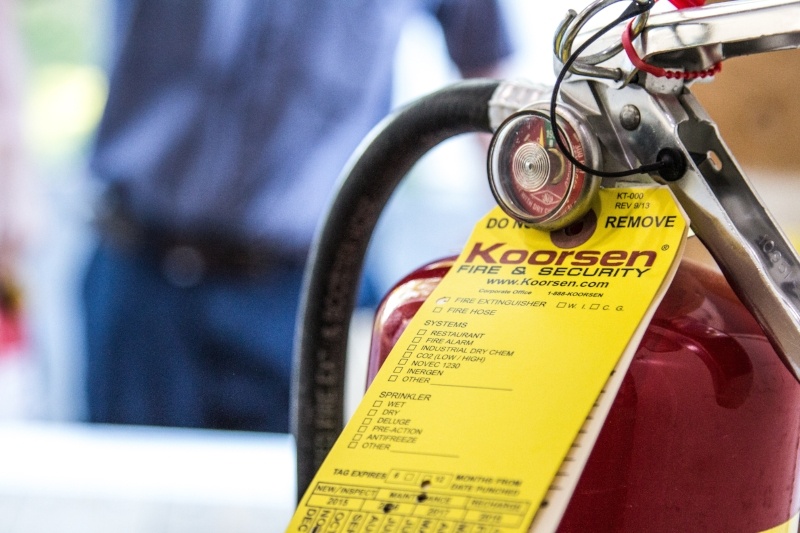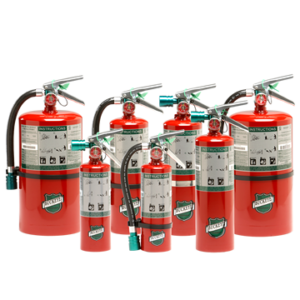
Halotron and CO2 extinguishers each have their advantages. Carbon dioxide is a trusted non-conductive clean agent and is most effective when used in electronic equipment fires. Halotron is a clean, non-conductive gaseous agent that is an excellent replacement for Halon 1211 extinguishers because it has a lower environmental impact and leaves no residue.
Halotron interrupts the chemical chain reaction and cools the fuel to extinguish the fire. Carbon dioxide displaces oxygen and cools the fuel to extinguish the fire. Both Halotron and CO2 are rated for Class B and Class C fires while Halotron extinguishers over 11 lbs are rated for Class A also. Now that you’re more familiar with how each agent works, let’s talk about the differences between the two.

Discharge Time and Distance
The discharge range varies based on the size of the extinguisher. As you can see below,
Halotron is capable of extinguishing a fire at a further distance than a CO2 fire extinguisher. While the Halotron extinguishers fully discharge more quickly than CO2 fire extinguishers, the extended range and the more concentrated agent of Halotron make up for this slight disadvantage.
| CO2 |
Time (in seconds) |
Range | Halotron |
Time (in seconds) |
Range |
|---|---|---|---|---|---|
| 10 lb | 11 | 3-8 ft | 5 lb | 9 | 9-15 ft |
| 15 lb | 14.5 | 3-8 ft | 11 lb | 9 | 9-15 ft |
| 20 lb | 19.2 | 3-8 ft | 15.5 lb | 14 | 12-18 ft |
Hydrotest Frequency
CO2 extinguishers require a hydro test every five years, while a Halotron extinguisher requires a hydro test every twelve years.
| Extinguisher Type | Test Frequency |
| CO2 | 5 years |
| Halotron |
12 years with 6-year maintenance |
Service Intervals
Every type of fire extinguisher needs to be serviced following any use. All portable fire extinguishers are required to have annual maintenance performed on them. In addition to this annual maintenance, Halotron units are required to have an internal examination every six years.
Additional Advantages of Halotron
Halotron extinguishers have a few additional advantages when compared to a CO2 extinguisher.

- Pressure Gauge Included – This allows you to confirm that the extinguisher is still keeping the agent at the correct pressure to ensure it will work when needed.
- Lower PSI – Halotron has an average of 125 psi compared to a CO2 extinguisher average of 800-900 psi.
- No Thermal or Static Shock Potential – Manufacturers say that you will not have a chance of thermal or static shock with Halotron. You do have those risks with CO2 extinguishers.
- UL Rating for Class A Fires – Halotron can be used on Class A fires if it is an 11lb or 15.5lb extinguisher. The smaller Haltron extinguishers do not qualify for a Class A rating.
Ask the Experts
The differences between CO2 and Halotron extinguishers need to be considered and evaluated for your specific business or facility. Contact a fire extinguisher expert from Koorsen Fire & Security today to have your questions answered. It is important that your facility is equipped with the proper fire extinguishers in case of an emergency.
Contact Koorsen today for assistance with finding the solution for your fire extinguisher needs. One of our extensively trained technicians can visit your business to discuss the different types of fire extinguishers and what works best for your facility in more detail.

